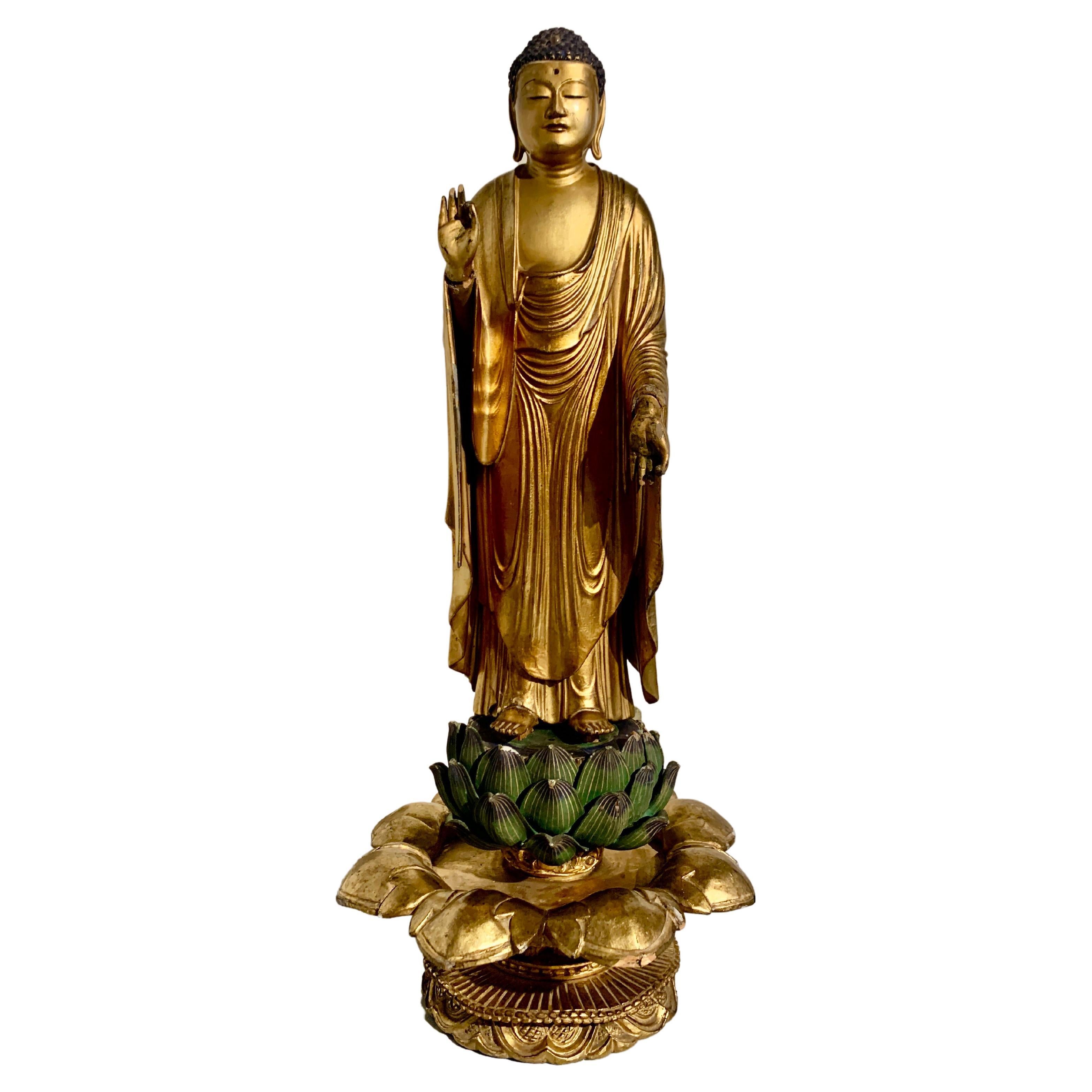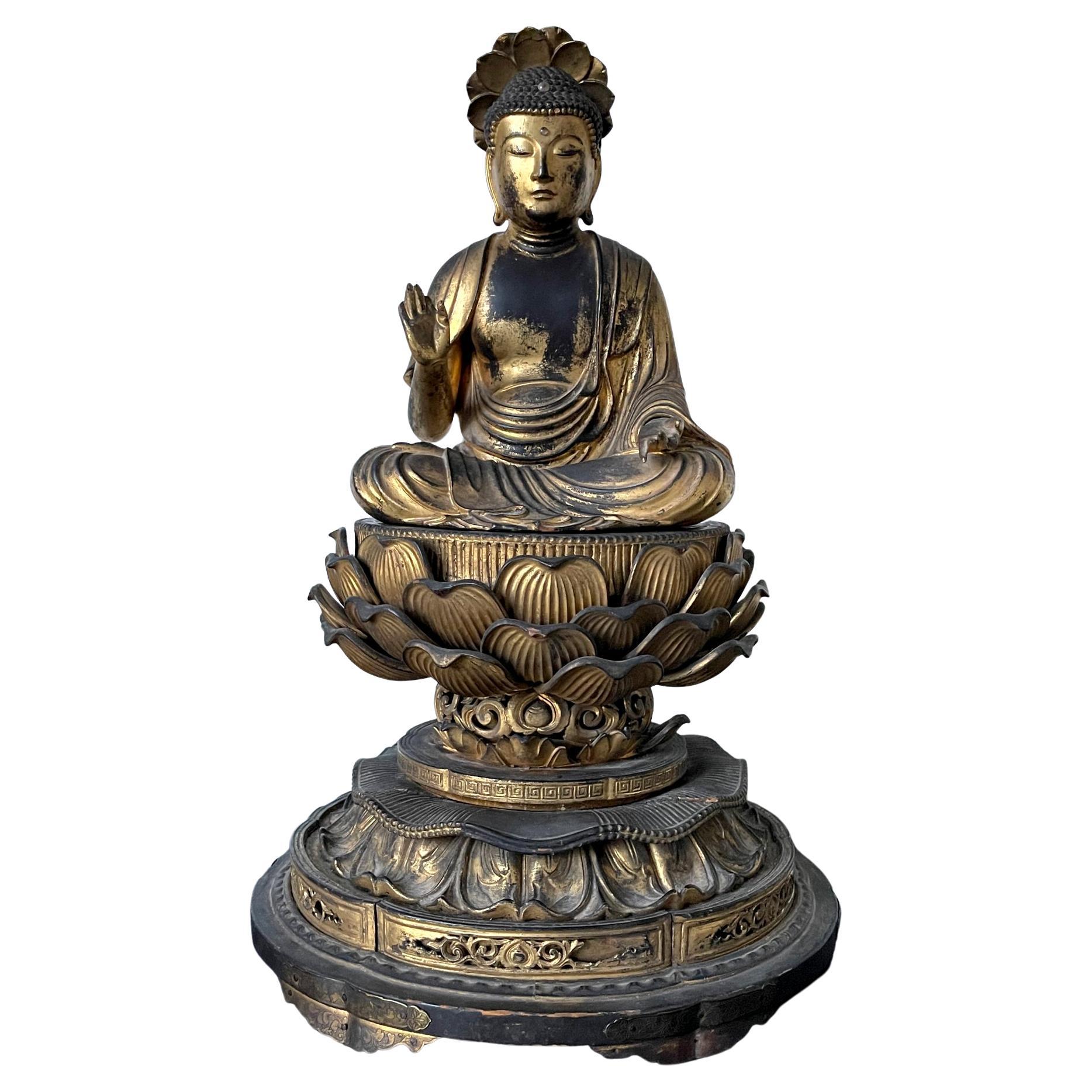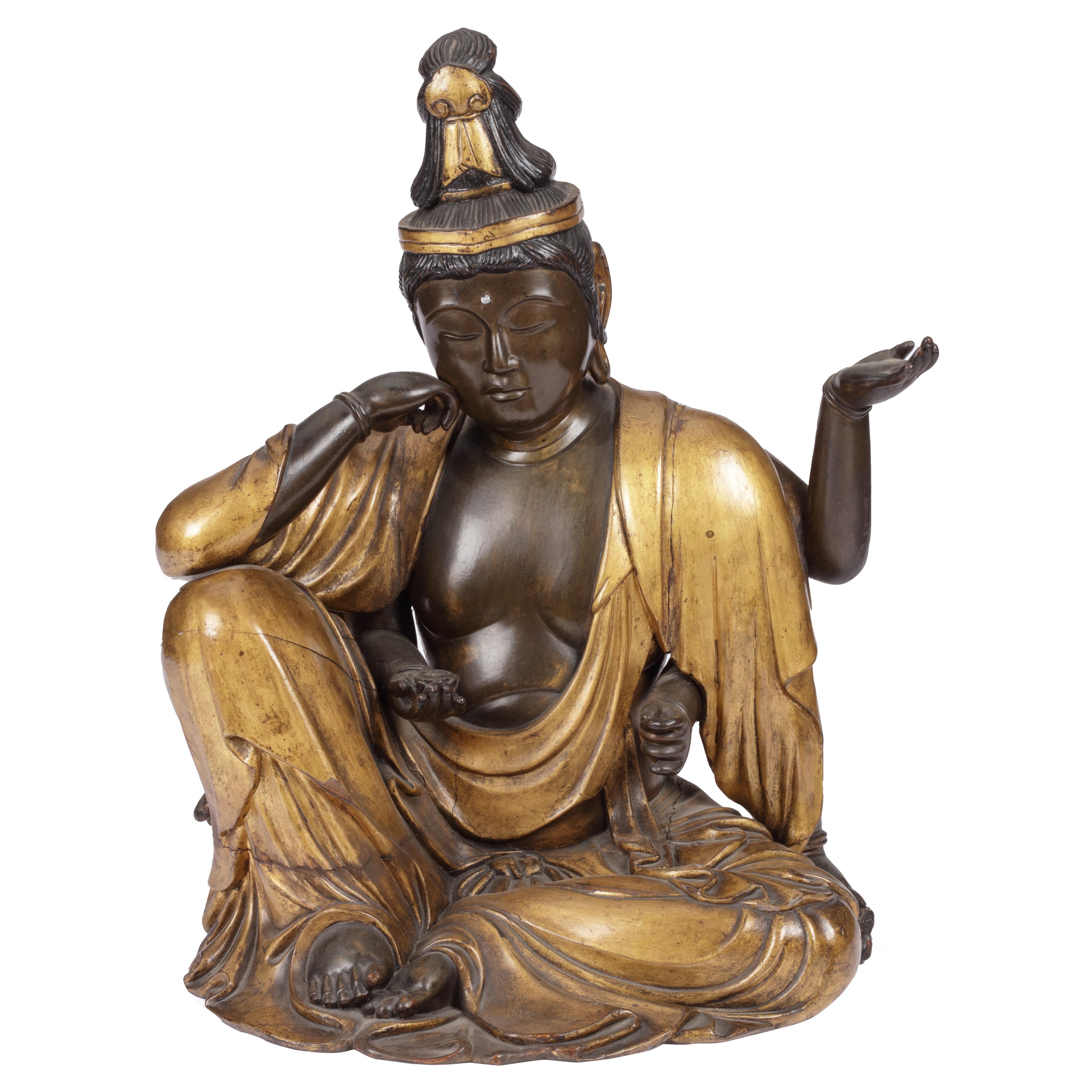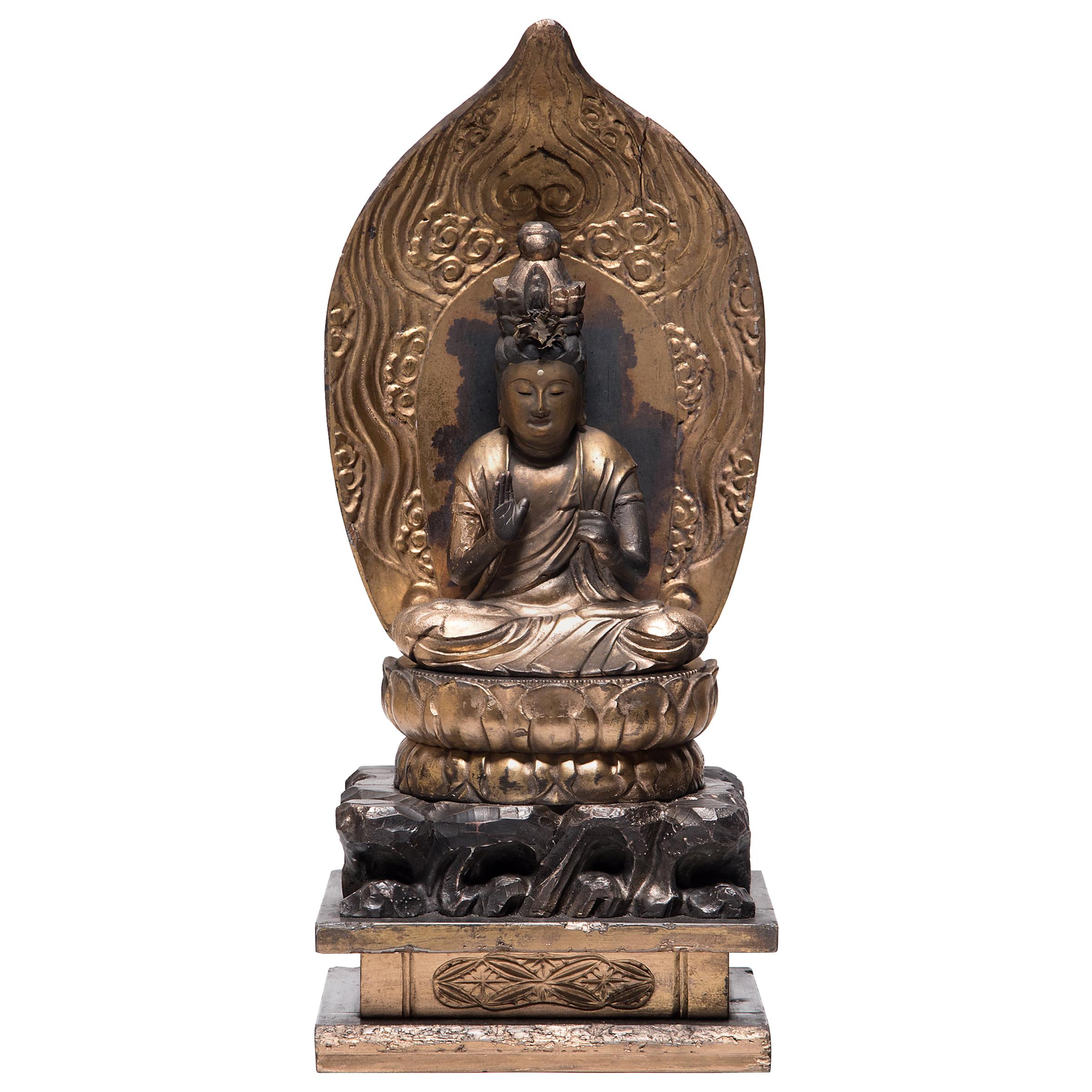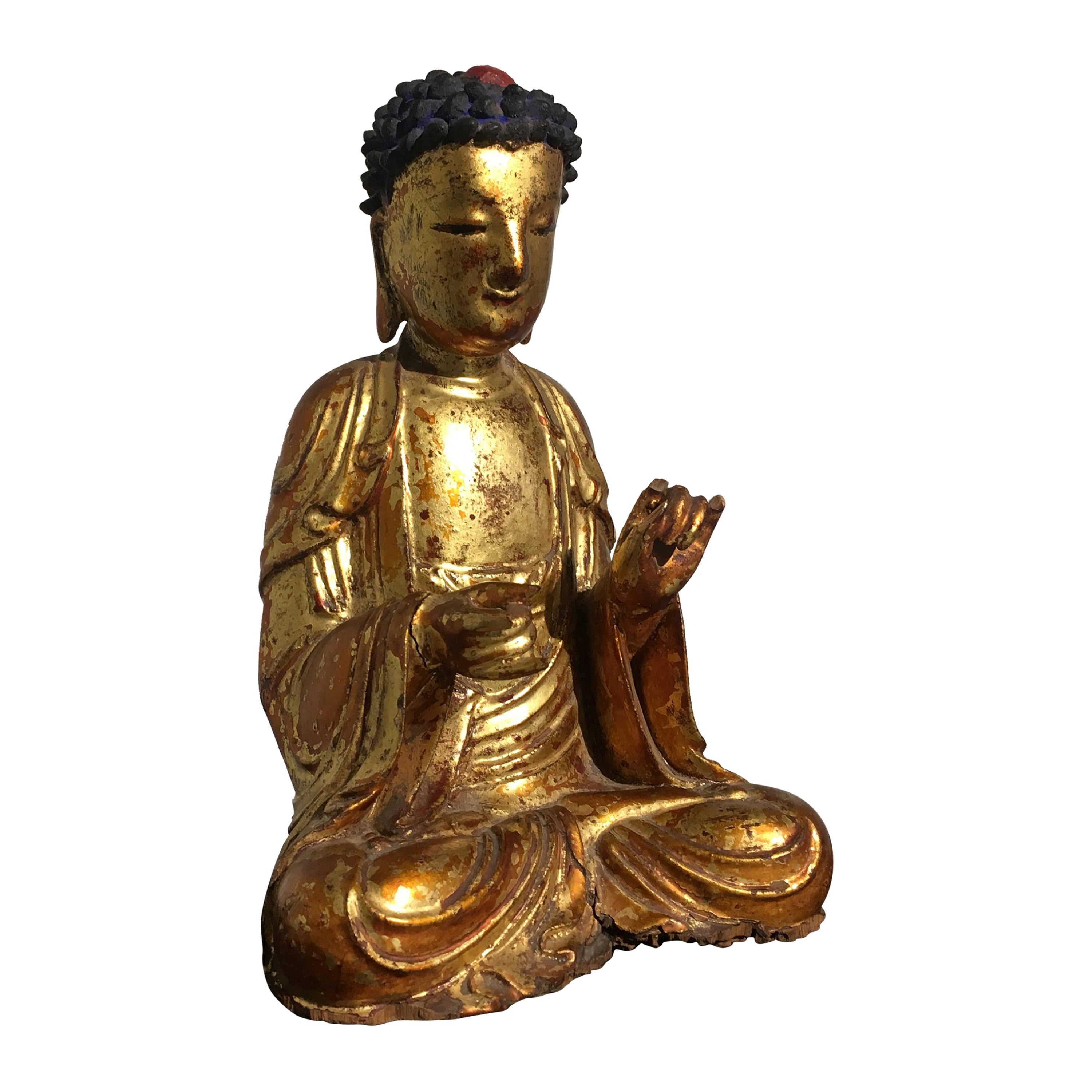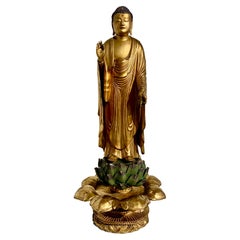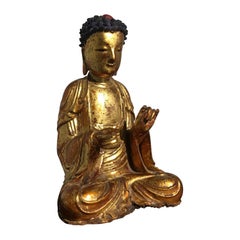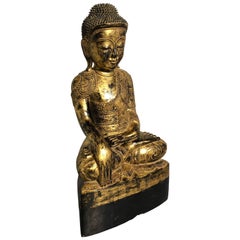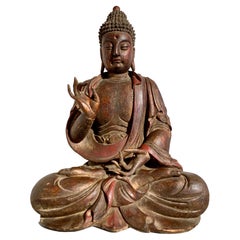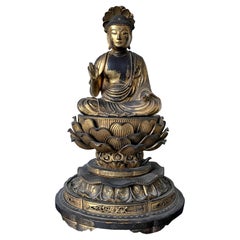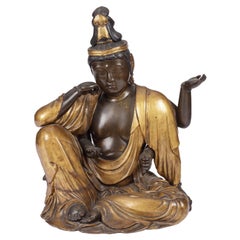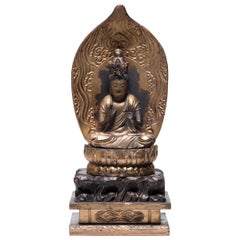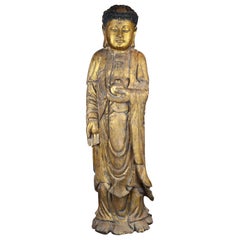Items Similar to Japanese Giltwood Medicine Buddha, Yakushi Nyorai, Muromachi Period 16th Century
Want more images or videos?
Request additional images or videos from the seller
1 of 17
Japanese Giltwood Medicine Buddha, Yakushi Nyorai, Muromachi Period 16th Century
$22,000
£16,820.17
€19,373.44
CA$30,828.75
A$34,417.39
CHF 18,034.20
MX$421,302.70
NOK 229,034.49
SEK 215,950.44
DKK 144,585.97
Shipping
Retrieving quote...The 1stDibs Promise:
Authenticity Guarantee,
Money-Back Guarantee,
24-Hour Cancellation
About the Item
A striking Japanese late Muromachi Period (1333-1573) lacquered and giltwood figure of Yakushi Nyorai, the Medicine Buddha, seated upon an elaborate carved openwork lotus pedestal, Japan, mid-16th century.
The Medicine Buddha, known as Yakushi Nyorai in Japan, is seated upon a large and elaborate multi-tiered lotus pedestal. Yakushi Nyorai is dressed in the typical robes of the Buddha, with his chest exposed. His voluminous robes drape and pool elegantly around his robust figure.
He holds up one hand in abhaya mudra, the gesture of dispelling fear. In his other hand, he holds a medicine pot shaped as a lotus bud, his identifying attribute. His hair is arranged neatly in rows of tight curls. He has painted rock crystal inset eyes, as well as a rock crystal orbs to the middle of his forehead and the front of the ushnisha.
The tall pedestal Yakushi Nyorai sits upon is masterfully carved. The top section features a large and bold upturned lotus pedestal, with individually carved overlapping petals in three tiers. The lotus sits upon a round cloud pillow with a separately carved lotus petal surround. The lotus is supported underneath by a lion that crouches upon a downturned lotus pedestal. A two-tiered stepped pedestal reminiscent of temple or pagoda architecture, complete with decorative railings, supports the entire structure.
The Buddha figure is created from separate blocks of cypress carved and joined together for form the full figure, which is then lacquered and gilded. The figure most likely with the original consecration or dedicatory material to the interior, as there is movement to the interior when the piece is picked up.
Yakushi Nyorai, the Medicine Buddha, is an important figure in the Japanese Buddhist pantheon. Patrons would often commission images of Yakushi Nyorai as a symbol of thanksgiving after recovering from an illness, ascribing their recovery to the Medicine Buddha.
- Dimensions:Height: 20.5 in (52.07 cm)Width: 12 in (30.48 cm)Depth: 11 in (27.94 cm)
- Style:Edo (Of the Period)
- Materials and Techniques:
- Place of Origin:
- Period:
- Date of Manufacture:circa 1550
- Condition:Repaired: The pedestal with evidence of glue repairs. Wear consistent with age and use. Minor losses. Minor fading. The Buddha: scattered losses, including missing a thumb, and part of the ear; gilding mostly gone, with the lacquer flaking in some areas. The pedestal: loss to some elements, evidence of gluing. Missing the halo. Please see photos.
- Seller Location:Austin, TX
- Reference Number:1stDibs: LU894716136351
About the Seller
5.0
Platinum Seller
Premium sellers with a 4.7+ rating and 24-hour response times
Established in 2001
1stDibs seller since 2010
345 sales on 1stDibs
Typical response time: <1 hour
- ShippingRetrieving quote...Shipping from: Austin, TX
- Return Policy
Authenticity Guarantee
In the unlikely event there’s an issue with an item’s authenticity, contact us within 1 year for a full refund. DetailsMoney-Back Guarantee
If your item is not as described, is damaged in transit, or does not arrive, contact us within 7 days for a full refund. Details24-Hour Cancellation
You have a 24-hour grace period in which to reconsider your purchase, with no questions asked.Vetted Professional Sellers
Our world-class sellers must adhere to strict standards for service and quality, maintaining the integrity of our listings.Price-Match Guarantee
If you find that a seller listed the same item for a lower price elsewhere, we’ll match it.Trusted Global Delivery
Our best-in-class carrier network provides specialized shipping options worldwide, including custom delivery.More From This Seller
View AllJapanese Standing Gilt Buddha, Amida Nyorai, Edo Period, 18th century, Japan
Located in Austin, TX
An exquisite Japanese carved hinoki and gilt lacquered standing figure of Amida Nyorai, Amitabha Buddha, Edo Period, 18th century, Japan.
The spectacular fully gold gilt figure of A...
Category
Antique 18th Century Japanese Edo Sculptures and Carvings
Materials
Rock Crystal
Korean Carved and Giltwood Buddha, Joseon Dynasty, 19th Century
Located in Austin, TX
A sublime and well carved Korean lacquered and gilt wood figure of Amitabha Buddha (Amita Bul), Joseon Dynasty, early 19th century, Korea.
The Budd...
Category
Antique Early 19th Century Korean Sculptures and Carvings
Materials
Wood
Burmese Ava Period Carved, Lacquered and Giltwood Buddha, Late 18th Century
Located in Austin, TX
A sublime and rare late 18th century Burmese Ava period carved, lacquered and gilt Buddha. The historical Buddha, Shakyamuni, is portrayed in bhumisparsha mudra, the gesture of calling the Earth to witness, commemorating the moment the Buddha reached enlightenment.
The Buddha is dressed in patchwork...
Category
Antique Late 18th Century Burmese Sculptures and Carvings
Materials
Wood
Large Chinese Carved and Lacquered Buddha, Qing Dynasty, 19th Century
Located in Austin, TX
A large and magnificent near life-sized Chinese carved and lacquered wood figure of a Buddha, Qing Dynasty, 19th century or earlier, southern China.
The figure likely represents one of the Five Tathagatas, also known as Dhyani Buddhas or Wisdom Buddhas. More specifically, either Amitabha or Amoghasiddhi. Amitabha is the Buddha of infinite light, and represents the wisdom of observation and recognition. Amoghasiddhi is the Buddha of accomplishment, and represents the wisdom of perfected practices. The size and scale of the Buddha indicates it was made for temple worship.
The large Buddha is portrayed seated in vajrasana, or full lotus position, with the soles of both feet facing up. His elegant hands, with impossibly long and slender fingers, perform shuni mudra, the gesture of bestowing patience. His right arm is bent at the elbow, the right hand raised to heart level. The left arm resting gently in his lap, the left hand at navel level.
The Buddha is dressed in voluminous robes that wrap around his shoulders and body, and tied at the waist. The heavy fabric draping and pooling elegantly all around his robust body. His broad chest and right arm exposed.
The Buddha's face is both solemn and beatific - his expression seeming to change depending on the angle of view. The most notable feature of his face is the large urna to the center of his forehead, set between a pair of painted, high arching brows over heavily lidded almond shaped eyes. A strong nose is set above a small mouth pursed in an ever so slight smile. Long pendulous earlobes touch his shoulders.
The Buddha's hair arranged in the typical fashion, with "spikes" representing tight curls. A prominent ushnisha rises from the crown of his head, covered by more hair, and topped with a rounded protuberance.
The Buddha is constructed from several blocks of wood, joined, carved and lacquered a deep red-brown with gold flecks...
Category
Antique 19th Century Chinese Qing Sculptures and Carvings
Materials
Wood
Chinese Ming Dynasty Lacquered and Gilt Bronze Bodhisattva, 17th Century
Located in Austin, TX
Chinese late Ming dynasty bronze figure of the Bodhisattva Avalokiteshvara, also known as Guanyin (Quan Yin, Kwan Yin, Kuan Yin), 17th century, China
The figure well cast in two ...
Category
Antique Mid-17th Century Chinese Ming Sculptures and Carvings
Materials
Bronze
Japanese Lacquered Wood Sho Kannon, Momoyama/Edo Period, 17th Century, Japan
Located in Austin, TX
A tall and impressive Japanese carved and black lacquered figure of Sho Kannon Bosatsu, Momoyama or Edo Period, mid 17th century, on a later mid 19th century carved, painted, and gilt wood lotus...
Category
Antique Mid-17th Century Japanese Edo Sculptures and Carvings
Materials
Metal
You May Also Like
Japanese Antique Gilt Wood Amitabha Buddha on Loctus Throne Statue
Located in Atlanta, GA
A Japanese carved wood Amitabha (Amida) Buddha statue with residual gold leafed surface circa 19th century (late Edo period). The buddha is seated in the padmasana position on an elevated double lotus throne, under a small lotus halo canopy. His right hand is held in abhaya mudra which means fearlessness in Sanskrit. The mudra symbolizes protection, peace, and fearless. His left hand gently resting on his thigh. Dressed in a flowing robe with open chest, the statue showcases a classic iconography found prominently in Japanese Buddhism art during Edo to Meiji period, characterized by the double lotus throne and a particularly serene meditative facial expression, highlighted by inset gemstones...
Category
Antique 19th Century Japanese Edo Sculptures and Carvings
Materials
Gold Leaf
A superb Japanese giltwood sculpture of Kannon Bosatzu
Located in Amsterdam, NL
A Japanese giltwood sculpture of Kannon Bosatzu
Japan, Edo period, Early 19th century
H. 50 X W. 58.3 cm
Provenance:
- The Somerwil Collection of ...
Category
Antique Early 19th Century Japanese Edo Sculptures and Carvings
Materials
Giltwood
Japanese Gilt Seated Kannon Figure, circa 1850
Located in Chicago, IL
Intricately carved and finished with gilt black lacquer, this seated figure depicts the bodhisattva Guanyin, known in Japanese Buddhism as Kannon. Described as the "Buddha of Infinite Compassion," Kannon is the embodiment of mercy and makes himself available to all who call upon him with all their mind.
Kannon is depicted here seated in diamond position upon a double lotus plinth, set above a stepped base. He is dressed in gracefully draped robes and wears a tall crown bearing a minuscule figure of Amida, the Buddha of Infinite Light. He has a serene expression of calm and holds his right hand in the abhaya mudra, a gesture of comfort, blessing, and protection. Backed by a magnificent leaf-form nimbus, this Kannon figure...
Category
Antique Mid-19th Century Japanese Edo Sculptures and Carvings
Materials
Wood, Lacquer
19th Century Chinese Antique Wooden Figure of the Medicine Buddha Bhaishajyaguru
Located in West Palm Beach, FL
A large, antique Chinese figure of the Medicine Buddha Bhaishajyaguru made of hand crafted gilded, partly lacquered Tropical wood, in good condition. The sculpture is dressed in a fl...
Category
Antique Late 19th Century Chinese Abstract Sculptures
Materials
Wood, Giltwood
JAPAN Edo Period 1825 Seated Buddha Sculpture In Solid Gilded Carved Wood
Located in Miami, FL
A seated Buddha sculpture in gilt carved wood from the Edo Period.
This is a superbly refined carved wooden figure of a seated Buddha with fabulous pure gold gilt. The sculpture has...
Category
Antique 1820s Japanese Edo Sculptures and Carvings
Materials
Gold
Edo Period Japanese Bodhisattva Shrine
Located in Chicago, IL
An incredible Edo Period Japanese gilt and lacquered carved wood shrine depicting a Bodhisattva with piercing glass eyes, a contemplative expression, and h...
Category
Antique Early 1800s Japanese Japonisme Sculptures and Carvings
Materials
Giltwood, Lacquer, Wood
$13,125 Sale Price
25% Off
More Ways To Browse
Japanese Step
Crystal Japanese
Antique Cypress
Antique Cypress Furniture
16th Century Japanese
Japanese Buddha
16th Century Dress
Japanese Buddhist Sculpture
Lacquered Buddha
Buddha Figures
Japanese Lion
Large Carved Buddha
Japanese Temple Sculpture
Large Japanese Pot
Japanese Buddha Sculpture
Tall Buddha Sculpture
Pagoda Sculpture
Japanese Lacquer Chest Antique
